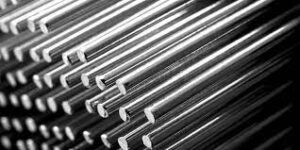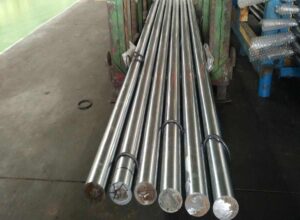Tool Steel in Woodworking: A Balance of Strength and Precision
 From the precision of cabinetry to the strength of structural beams, woodworking depends on quality tools. Tool steels enable the sharp blades, durable jigs, and smooth surfaces that bring ideas to life in wood. By balancing hardness with fracture toughness, these alloys form the chisels, planes, and abrasives at the core of fine wood craftsmanship.
From the precision of cabinetry to the strength of structural beams, woodworking depends on quality tools. Tool steels enable the sharp blades, durable jigs, and smooth surfaces that bring ideas to life in wood. By balancing hardness with fracture toughness, these alloys form the chisels, planes, and abrasives at the core of fine wood craftsmanship.
In this article, we’ll explore the art of blending tool steel strength and precision for exceptional woodworking. Discover how tailored hardness and microstructures shape, slice, and smooth wood with finesse. See how slight differences in formulation and heat treatment manifest as smoother planed surfaces or sharper turning tools. The right tool steel optimizes the utility and beauty crafted from wood.
An Introduction to Tool Steels for Woodworking
Tool steels refer to the family of specialty carbon and alloy steels engineered to withstand the rigors of machining, pressing, casting, plastic molding, and abrasive polishing work. Key attributes include:
- Hardness for wear resistance when cutting and shaping
- Strength to withstand cutting forces without warping
- Toughness that resists chipping or fracturing under load
- Stability to hold form across repeated thermal cycles
- Corrosion resistance in wet woodworking environments
- Dimensional precision essential for tight-fitting joints and fixtures
These properties make tool steels ideal for the blades, bits, guides, and abrasives needed to shape and finish wood with exactness and efficiency. Optimized grades enhance the quality and precision of wood projects.
The Right Hardness: Sharpness vs. Toughness
A key consideration for any woodworking tool steel is balancing hardness against required toughness:
- Hardness correlate to wear resistance and edge sharpness. But taken too far, excessive hardness leads to brittleness.
- Toughness measures a steel’s ability to resist fracturing under load. Greater toughness handles high forces from wood cutting and milling.
- An optimal combination couples hardness for sharp, durable edges with sufficient fracture resistance against the forces and impacts of woodworking.
- Minor differences in composition and heat treating fine-tune hardness versus toughness. Molybdenum and cobalt tend to increase toughness. Higher carbon boosts hardness.
The winning balance pairs just enough toughness to complement high hardness. This delivers wood cutting tools and blades that stay sharp without chipping or breaking.
Key Alloying Elements for Woodworking
Various alloying elements refine tool steel properties for woodworking:
- Carbon forms hard carbides with chromium, vanadium, molybdenum, and tungsten that boost wear resistance. But too much carbon risks brittleness.
- Chromium enhances corrosion resistance needed in wet wood environments while contributing to hardenability. 13%+ makes stainless grades.
- Molybdenum improves strength and machinability. In larger amounts, molybdenum contributes wear resistance.
- Vanadium forms hard vanadium carbides while refining grain size for hardness and strength.
- Manganese combines with sulfur impurities, improving machinability. Manganese also aids hardening response.
- Cobalt enables high hardness while maintaining good toughness and sharpenability.
Fine-tuning these elements allows tailoring tool steel to woodworking demands.
Heat Treating Refines Properties
The properties of tool steels fully manifest after proper heat treatment:
- Hardening through heating and rapid quenching forms martensite to achieve the desired hardness and strength. Oil, water, air, or polymers quench depending on required properties.
- Tempering follows hardening to relieve stresses and refine hardness. Two or three tempers at progressively lower temperatures optimize toughness.
- Annealing requires slowly cooling after heating to soften the steel for improved machinability when fabricating tools.
- Stress relieving at low temperatures releases locked-in stresses from material processing and machining before final grinding.
When performed skillfully, heat treating unlocks the ideal tool steel properties for woodworking.
Key Tool Steel Grades for Woodworking
Many tool steel types see use for cutting, shaping, and finishing wood:
O1, A2 – Oil Hardening Steel
General purpose tool steel offering a good balance of hardness, toughness, and ease of sharpening. Used for hand tools like chisels and planes.
M2 – High Speed Steel
The original high speed steel. Hardness and red hardness for sharp, long-lasting cutters, saws, drills, and router bits. Cobalt-enriched grades further boost heat resistance.
D2 – Cold Work Steel
A versatile cold work steel hardened by air quenching. Provides excellent hardness for punches and dies when impact forces are minimal.
S1, S5, S7 – Shock Resisting
Added chromium improves toughness and shock resistance for chisels, ax blades, and other high-impact tools.
H13 – Hot Work Steel
Popular as a die steel, H13 also serves well for hot wood bending and laminating presses needing durability at elevated temperatures up to 1000°F (540°C).
420, 440C – Stainless
Corrosion resistant with good hardness and polishability. Used for knives, scrapers, moisture prone jigs, and food contact surfaces.
The optimal grade depends on the woodworking tool function and processes encountered.
Abrasives: Cutting Away Differently
While most woodworking emphasizes removing material in small amounts slowly over many sharpenings, abrasives take the opposite approach. By utilizing huge numbers of hard, sharp points, tool steel abrasives cut away large amounts of material rapidly. Different forms include:
Sandpaper
Tiny grains of aluminum oxide, silicon carbide, or garnet adhered to paper rapidly smooth and contour wood. Harder than the particles, the flexible paper backing prevents gouging.
Files
Rows of individually cut teeth made from hardened tool steel rapidly shape wood and rapidly remove stock. Curved, flat, and riffler files suit different applications.
Grinding Wheels
Disks of tool steel with embedded industrial diamond or silicon carbide grits aggressively grind away stock. Bonded composites balance cutting action and wheel integrity.
Burrs and Rotary Rasps
Small, coarse grain tungsten carbide or industrial diamond burrs and rasps quickly remove wood for shaping and deburring. Stainless steel shanks support the abrasive tips.
Tool steel delivers both the soft matrix supporting cutting grains and the durable sharp particles themselves for rapid abrasive action.
Precision in Fixtures and Guides
 Beyond cutting, tool steels construct the guides, gauges, and fixtures that enable precision wood joinery and assembly:
Beyond cutting, tool steels construct the guides, gauges, and fixtures that enable precision wood joinery and assembly:
- Linear guides keep cutting tools running true. Tool steel maintains slide accuracy despite sawdust and debris.
- Close tolerance drill bushings guarantee precision hole placement. Stainless steel resists moisture and remains dimensionally stable.
- Durable jig plates and workholding fixtures withstand clamping forces and machining over time. Precision ground to avoid any warp or twist.
- Thin feeler gauges consistently measure tiny gaps for perfect fit joints. Rust-resistant tool steel retains stiffness without bending.
- Interchangeable router templates guarantee uniformly shaped decorative edges and cutouts. Wear resistance maintains clean contours.
The rigidity, corrosion resistance, and dimensional stability of tool steels enable woodworking precision of the highest caliber.
Tool Steel for the Woodturner
On the lathe, tool steels construct cutting implements able to shear, slice, and peel wood with finesse:
Cutting Edges
Parting tools, skews, gouges, and scrapers involve high-speed or stainless tool steel edges expertly sharpened for turning. Durable, fine-grained alloys maintain the keen edge.
Support Shanks
Stainless or tool steel shanks secure carbide, ceramic, or specialty steel cutters to withstand centrifugal forces while damping vibration. Precision cylindrical forms fit chucks and tool rests.
Specialty Inserts
Indexable carbide, ceramic, CBN, and exotic alloy inserts attach to tool steel shanks for replaceable cutters. Complex tipped profiles shape intricate profiles not possible through grinding alone.
Lathe Chisels
Woodturning chisels require a keen, strong edge. Tool steel’s hardness optimizes sharpness. Alloying additions boost fracture resistance against lathe catches.
On the lathe, tool steel combines strength, vibration resistance, and machinability to support specialized cutters and deliver smooth turning.
Key Takeaways on Tool Steels in Woodworking
Tool steels refine all facets of woodworking:
- Balancing hardness for sharp, long-lasting edges with needed toughness against wood’s forces
- Alloying elements like chromium, molybdenum, vanadium, and cobalt fine-tune properties for wood’s demands
- Heat treating manifests strength, hardness, and dimensional stability not present after simply machining
- Different grades suit specific needs from cold work strength to wear resistance to corrosion barriers
- Abrasives utilize tool steel’s hardness to carry machining and finishing grains
- Precision guides, fixtures, and gauges depend on tool steel’s rigidity and dimensional accuracy
- Turning implements benefit from both tool steel support shafts and specialized cutting edges
With the right properties, tool steels empower crafters to achieve both utility and artistry in wood. This versatile metal will continue serving woodworking’s finest into the future.
FAQ
How do tool steels benefit woodworking blades and cutting implements?
Tool steels offer:
- Hardness for sharp, wear-resistant cutting edges
- Toughness to resist fracturing from wood’s forces
- Stability to maintain form through repeated sharpenings
- Corrosion resistance in wet environments
- Ability to finely hone and polish a keen edge
This enables durable, precisely machined cutting tools.
What tool steel properties make them ideal for woodworking fixtures?
For jigs, fixtures, gauges and guides, tool steels provide:
- Dimensional stability to retain precision
- Strength and stiffness for rigidity
- Wear resistance for smooth sliding fits
- Corrosion resistance in humid workshop environments
What tool steel grades work well for wood chisels and hand tools?
O1 and A2 oil-hardening tool steels offer an excellent balance of hardness, toughness, and ease of sharpening desired for wood chisels, hand planes, and related hand tools. Their combination of properties make them ideal for these general purpose woodworking tools.
Why is toughness important for tool steels used in woodworking?
The cutting forces encountered when shaping wood can fracture a tool steel that is too brittle. Toughness indicates a tool steel’s resistance to fracturing under load. A measure of impact strength, sufficient toughness ensures cutting edges can withstand intermittent forces from dense knots, grains changes, or catches when woodturning without chipping or breaking prematurely.
How do tool steels used for woodworking abrasives differ from cutting tool steels?
Abrasive tool steels act as a hard matrix to support sharp abrasive grains that cut away large amounts of material. The matrix needs consistent hardness to avoid gouging. By contrast, cutting tool steels require keen, shaped edges and enough toughness to resist fracturing under wood cutting forces. The tool steel properties are tailored to the different needs.

